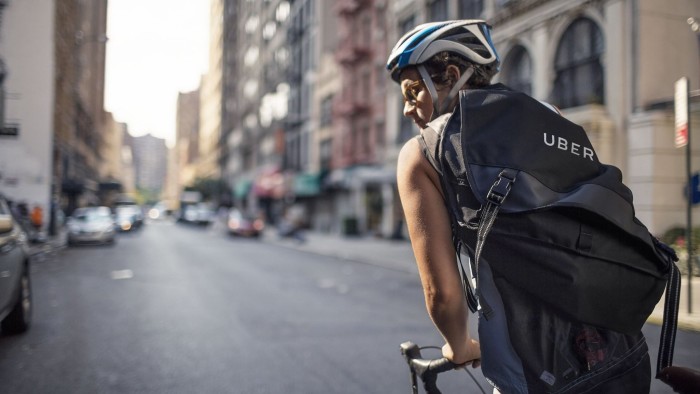Uber looms over the parcel delivery business

Roula Khalaf, Editor of the FT, selects her favourite stories in this weekly newsletter.
From taxis to trucks, there are few areas of road transport where Uber Technologies has not already provoked anxiety, anger or dismay among rival traditional operators.
Founded in 2009 as UberCab by entrepreneurs Travis Kalanick and Garrett Camp in San Francisco, its app-based system allows users to summon minicabs mainly operated by owner-drivers who are contracted to Uber.
It has grown like wildfire around the world and reached its billionth ride on Christmas Eve 2015.
Now DHL, FedEx, Royal Mail and other courier and delivery companies are bracing themselves for an expansion of the group’s North American UberRush service into Europe. Demand in the sector has been driven by a boom in internet shopping. In the UK in 2015, 76 per cent of adults bought goods or services online; in 2008 it was 53 per cent, according to the Office for National Statistics.
Uber says it “currently” has no plans to launch UberRush in the UK. “It’s too early to say,” comments an Uber spokesman, describing the US operations of UberRush as “trial activities”. However, success in the US could lead to a UK rollout, he concedes.
Established delivery services are convinced that such a move is imminent. They assume UberRush will use the same smartphone technology that allows businesses to summon vans at a moment’s notice and has already allowed it to carve deeply into traditional black cab and minicab businesses.
As in North America, UberRush is likely to target clients along the full spectrum of businesses from large corporations to small independent stores.
In the UK the prospect adds significantly to concern at Royal Mail, which is already grappling with inroads on its parcels operations by internet retailer Amazon. Royal Mail reported a 31 per cent drop in profits in the six months to the end of September 2015. Moya Greene, chief executive, had warned previously that Amazon’s move could halve the growth potential of Royal Mail’s parcels business over the next several years and hit other rivals. “When an online retailer of the scale and size of Amazon decides to build its own delivery network, that changes the market for everybody,” she said.
Gary Paulin, co-founder of equity brokerage Aviate Global, predicts that the traditional companies in the sector will not disappear but are unlikely to retain anything like their past domination of the market. However, Deutsche Post’s DHL Group suggests the business model of the US group will turn out to be “relatively niche”.
It is easy to see the attraction for Uber: statistics from the UK’s Department for Transport show that last year vehicles of all types covered 7bn more miles in the country than in 2014. Vans and other light goods vehicles accounted for 2.34bn of those new miles. The miles driven by light goods vehicles, many delivering items ordered online, have risen 20 per cent in 10 years, according to the department’s estimates. The same-day courier service sector alone is now worth £7bn a year in the UK, according to market research group IBISWorld.
The extent of Uber’s ambitions is set out by parcels broker ParcelHero. It predicts that established couriers will be just as vulnerable to Uber’s app-based activities as the UK’s black cab trade, which to date has had at least 500 taxis disappear from London’s 25,000-strong fleet alone, according to the Licensed Taxi Drivers Association. The ParcelHero report predicts UberRush should be able to capture 10 per cent of the global market.
But the prize is much greater: worldwide annual revenue from taxi operations of all types is estimated at $22bn — a small part of the $246bn generated by global courier and parcels delivery services, as calculated by IBISWorld. Uber may yet have a bigger market to attack.
Comments